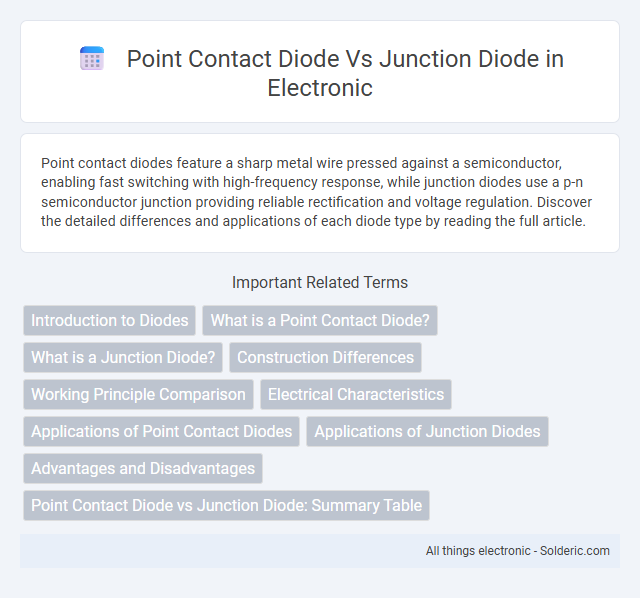Point contact diodes feature a sharp metal wire pressed against a semiconductor, enabling fast switching with high-frequency response, while junction diodes use a p-n semiconductor junction providing reliable rectification and voltage regulation. Discover the detailed differences and applications of each diode type by reading the full article.
Comparison Table
| Feature | Point Contact Diode | Junction Diode |
|---|---|---|
| Construction | Metal point contact on semiconductor | P-N junction formed by diffusion or alloying |
| Fabrication | Manually placed metal wire | Chemical processes, wafer-based |
| Switching Speed | Very fast, nanoseconds range | Fast, but slower than point contact |
| Lifetime | Short, less durable | Longer, more robust |
| Applications | High-frequency detectors, mixers | Rectifiers, signal modulation, general electronics |
| Electrical Characteristics | Low forward voltage drop, high leakage current | Higher forward voltage drop, lower leakage current |
| Cost | Lower cost, less consistent | Higher cost, consistent performance |
Introduction to Diodes
Point contact diodes feature a metal wire contacting a semiconductor crystal, creating a small-area junction ideal for high-frequency applications, whereas junction diodes use a p-n semiconductor junction formed by doping, providing higher reliability and current capacity. The distinct construction influences your choice of diode based on frequency, speed, and power requirements in electronic circuits. Point contact diodes excel in fast switching and microwave detection, while junction diodes are preferred for rectification and general-purpose tasks.
What is a Point Contact Diode?
A Point Contact Diode is a type of semiconductor diode formed by placing a thin metal wire in contact with a semiconductor crystal, creating a small rectifying junction. Unlike junction diodes, which have a well-defined p-n junction created by doping, point contact diodes rely on the metal-semiconductor interface to allow current flow in one direction. You can identify point contact diodes by their fast switching speed and sensitivity in high-frequency applications such as microwave detectors.
What is a Junction Diode?
A junction diode is a semiconductor device formed by joining p-type and n-type materials, creating a p-n junction that allows current to flow primarily in one direction. Unlike the point contact diode, which relies on a metal point contacting semiconductor material, the junction diode offers greater durability and efficiency due to its well-defined junction. Understanding the structure of your junction diode can help optimize electronic circuit design for rectification and signal modulation.
Construction Differences
Point contact diodes feature a metal wire tip lightly pressed against a semiconductor, creating a small, localized contact area, while junction diodes are formed by the interface of p-type and n-type semiconductor regions within a single crystal. The construction of point contact diodes allows for faster switching speeds due to minimal charge storage, whereas junction diodes provide better durability and higher current handling through a stable p-n junction. Your choice depends on whether you prioritize speed and sensitivity or robustness and power capacity.
Working Principle Comparison
Point contact diodes operate by forming a metal-semiconductor junction through a fine wire touching a semiconductor crystal, creating a localized depletion region that allows unidirectional current flow. In contrast, junction diodes rely on a p-n semiconductor junction formed by doping processes, where the depletion region is established at the interface of the differently doped semiconductor materials, enabling the rectification of current. The point contact diode's working principle emphasizes direct metal-semiconductor interaction for conduction, while the junction diode depends on the built-in electric field at the p-n junction for its operation.
Electrical Characteristics
Point contact diodes exhibit fast switching speeds and low forward voltage drops due to their small junction area, making them suitable for high-frequency applications. Junction diodes, with a larger semiconductor junction, typically offer higher current handling capacity and better stability but have slower response times. Your choice depends on the need for speed versus power handling in electronic circuit design.
Applications of Point Contact Diodes
Point contact diodes excel in high-frequency applications such as microwave detectors, mixers, and oscillators due to their fast switching speed and low capacitance. Their small junction area and unique construction make them ideal for signal demodulation in radar systems and RF communication devices. In contrast, junction diodes are primarily used for rectification, voltage regulation, and general-purpose switching where high-frequency performance is less critical.
Applications of Junction Diodes
Junction diodes find extensive applications in rectification, voltage regulation, and signal demodulation due to their reliable forward and reverse bias characteristics. They are integral in power supply circuits, clipping and clamping circuits, and protection devices against voltage spikes. Your electronic projects benefit from junction diodes' ability to handle higher current and voltage levels compared to point contact diodes.
Advantages and Disadvantages
Point contact diodes offer faster switching speeds and lower capacitance compared to junction diodes, making them suitable for high-frequency applications. However, they have lower durability and are more susceptible to noise and instability due to their fragile construction. Junction diodes provide better reliability, higher current capacity, and superior temperature stability but exhibit slower switching speeds and higher junction capacitance.
Point Contact Diode vs Junction Diode: Summary Table
Point contact diodes feature a metal wire contact pressed against a semiconductor, offering fast switching and low capacitance but limited power handling and stability, while junction diodes use a p-n semiconductor junction providing higher current capacity, better reliability, and voltage rectification. Point contact diodes are preferred in high-frequency mixer circuits, whereas junction diodes excel in rectification and switching applications. Key parameters distinguishing these diodes include their construction, response speed, power ratings, and typical applications, as summarized in comparative technical specifications.
Point contact diode vs junction diode Infographic

 solderic.com
solderic.com